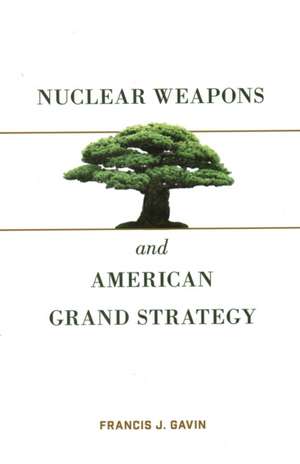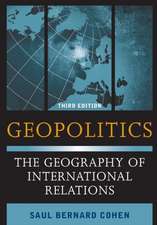Gavin, F: Nuclear Weapons and American Grand Strategy
Autor Francis J. Gavinen Limba Engleză Paperback – 20 ian 2020
Exploring what we know--and don't know--about how nuclear weapons shape American grand strategy and international relations
The world first confronted the power of nuclear weapons when the United States dropped atomic bombs on Hiroshima and Nagasaki in August 1945. The global threat of these weapons deepened in the following decades as more advanced weapons, aggressive strategies, and new nuclear powers emerged. Ever since, countless books, reports, and articles--and even a new field of academic inquiry called "security studies"--have tried to explain the so-called nuclear revolution.
Francis J. Gavin argues that scholarly and popular understanding of many key issues about nuclear weapons is incomplete at best and wrong at worst. Among these important, misunderstood issues are: how nuclear deterrence works; whether nuclear coercion is effective; how and why the United States chose its nuclear strategies; why countries develop their own nuclear weapons or choose not to do so; and, most fundamentally, whether nuclear weapons make the world safer or more dangerous.
These and similar questions still matter because nuclear danger is returning as a genuine threat. Emerging technologies and shifting great-power rivalries seem to herald a new type of cold war just three decades after the end of the U.S.-Soviet conflict that was characterized by periodic prospects of global Armageddon.
Nuclear Weapons and American Grand Strategy helps policymakers wrestle with the latest challenges. Written in a clear, accessible, and jargon-free manner, the book also offers insights for students, scholars, and others interested in both the history and future of nuclear danger.
Preț: 279.49 lei
Nou
53.49€ • 56.43$ • 44.58£
Carte tipărită la comandă
Livrare economică 03-17 ianuarie 25
Specificații
ISBN-10: 0815737912
Pagini: 322
Dimensiuni: 152 x 229 x 19 mm
Greutate: 0.52 kg
Editura: Brookings Institution Press
Descriere
Exploring what we know--and don't know--about how nuclear weapons shape American grand strategy and international relations
The world first confronted the power of nuclear weapons when the United States dropped atomic bombs on Hiroshima and Nagasaki in August 1945. The global threat of these weapons deepened in the following decades as more advanced weapons, aggressive strategies, and new nuclear powers emerged. Ever since, countless books, reports, and articles--and even a new field of academic inquiry called "security studies"--have tried to explain the so-called nuclear revolution.
Francis J. Gavin argues that scholarly and popular understanding of many key issues about nuclear weapons is incomplete at best and wrong at worst. Among these important, misunderstood issues are: how nuclear deterrence works; whether nuclear coercion is effective; how and why the United States chose its nuclear strategies; why countries develop their own nuclear weapons or choose not to do so; and, most fundamentally, whether nuclear weapons make the world safer or more dangerous.
These and similar questions still matter because nuclear danger is returning as a genuine threat. Emerging technologies and shifting great-power rivalries seem to herald a new type of cold war just three decades after the end of the U.S.-Soviet conflict that was characterized by periodic prospects of global Armageddon.
Nuclear Weapons and American Grand Strategy helps policymakers wrestle with the latest challenges. Written in a clear, accessible, and jargon-free manner, the book also offers insights for students, scholars, and others interested in both the history and future of nuclear danger.
Notă biografică
Cuprins
Preface
Acknowledgments
1. History and the Unanswered Questions of the Nuclear Age
2. Fixing the Franchise: The Ivory Tower-Policy Gap
3. What We Talk about When We Talk about Nuclear Weapons
4. Strategies of Inhibition
5. NATO's Radical Response to the Nuclear Revolution
6. Beyond Deterrence
7. The History of What Did Not Happen
8. Deterring while Disarming
9. Rethinking Nuclear Weapons and American Grand Strategy
Notes
Index




